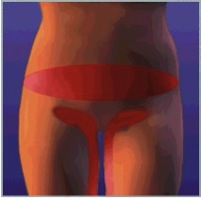
Gynaecological reasons for pelvic pain include
- Endometriosis
This is a condition where tissue that normally lines the cavity of the womb is found in other areas of the pelvis
- Adenomyosis
This is a condition where tissue that normally lines the cavity of the womb is found in the muscle of the womb.
Symptoms are usually pain during menstruation (dysmenorrhea) and heavy periods.
A good number of women who have endometriosis will also be found to have Adenomyosis
- Chronic pelvic inflammatory disease
About 10% of women who develop infection in the pelvis will go on to develop chronic pelvic pain.
Hysterectomy is not the first point of call for women with pelvic pain. It is important that women be properly investigated and alternative treatments considered before embarking on a hysterectomy particularly for pelvic pain.
Hysterectomy for Adenomyosis:
Adenomyosis is found in 20-30% of hysterectomy specimen. Though there are alternative treatments for Adenomyosis the overall failure rate is in the region of 20%.
Hysterectomy is superior to all other treatments for endometriosis.
Laparoscopic hysterectomy should be the ideal treatment choice.
Where possible the ovaries should be retained.
Because of the theoretical risk of persisting pain if there is also Adenomyosis in the cervix. The cervix is probably best removed at the same time.
In summary for Adenomyosis if hysterectomy is to be performed it is best carried out by the laparoscopic route the ovaries are best left behind but the cervix is best removed,
Hysterectomy for endometriosis
Hysterectomy is not the primary treatment for endometriosis. For women who have both endometriosis and Adenomyosis who have completed their families it is a good option for treatment of central pain.
Between 70-90% of women who have hysterectomy for pain symptoms of endometriosis will improve. For those who have pain during intercourse 60-70% will have some improvement.
Symptoms may recur in about 15% of women with between 3-8% requiring additional surgery
The laparoscopic route for hysterectomy is probably the best option.
If the ovaries are not involved in the endometriotic process they are best left behind.
It is important that if the ovaries are left behind that all visible pelvic endometriosis is removed.
If the ovaries need to be removed the majority of women will need to have Hormone replacement therapy.
There is a small risk that hormone replacement therapy may reactivate the endometriosis. this is usually in the region of about 1%
Women may also be advised to have the cervix removed.
The most important factor is removing all visible endometriosis as well as performing the hysterectomy.
- Hysterectomy for chronic PID
the laparoscopic hysterectomy is best for this group of women as it allows for adhesions to be broken down and the hysterectomy performed under visualisation.








 RSS Feed
RSS Feed